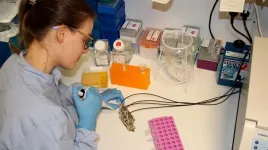(Press-News.org) Some people casually smoke cigarettes for a while and then stop without a problem, while others develop long-term, several packs-per-day habits. A complex mix of environmental, behavioral and genetic factors appear to raise this risk for nicotine dependence.
Studies of groups of twins suggest that 40 to 70 percent of the risk factors are heritable. Until recently, however, studies have only explained about 1 percent of the observed variation in liability to nicotine dependence, using a genetic score based on how many cigarettes a person smokes per day.
A new study led by psychologists at Emory University offers a new model for examining this genetic risk. It leveraged genome wide association studies for a range of different traits and disorders correlated with nicotine dependence and explained 3.6 percent of the variation in nicotine dependence.
The journal Nicotine & Tobacco Research published the finding.
Higher polygenetic scores for a risk for schizophrenia, depression, neuroticism, self-reported risk-taking, a high body mass index, alcohol use disorder, along with a higher number of cigarettes smoked per day were all indicators of a higher risk for nicotine dependence, the study found. And polygenetic scores associated with higher education attainment lowered the risk for nicotine dependence, the results showed.
"If you look at the joint effect of all of these characteristics, our model accounts for nearly 4 percent of the variation in nicotine dependence, or nearly four times as much as what we learn when relying solely on a genetic index for the number of cigarettes someone smokes daily," says Rohan Palmer, senior author of the study and assistant professor in Emory's Department of Psychology, where he heads the Behavioral Genetics of Addiction Laboratory.
"What we're finding," Palmer adds, "is that to better leverage genetic information, we need to go beyond individual human traits and disorders and think about how risk for different behaviors and traits are interrelated. This broader approach can give us a much better measure for whether someone is at risk for a mental disorder, such as nicotine dependence."
"All of the traits and diseases we looked at are polygenic, involving multiple genes," adds Victoria Risner, first author of the study, who did the work as an Emory undergraduate majoring in neuroscience and behavioral biology. "That means that millions of genetic variants likely go into a complete picture for all of the heritable risks for nicotine dependence."
The researchers hope that others will build on their multi-trait, polygenetic model and continue to boost the understanding of the risk for such complex disorders. "The more we learn, the closer we can get to one day having a genetic test that clinicians can use to inform their assessment of someone's risk for nicotine dependence," Palmer says.
Although the hazards of smoking are well established, about 14 percent of Americans report daily use of tobacco. Around 500,000 people die each year in the United States from smoking or exposure to smoke, and another 16 million live with serious illnesses caused by tobacco use, including cancer, cardiovascular disease and pulmonary disease. While the toxic chemicals produced during smoking and vaping are what cause harmful health effects, it's the addictive component of nicotine that hooks people on these habits.
Risner worked on the current paper for her honors thesis. "Nicotine dependence was interesting to me because the vaping scene was just arriving while I was an undergraduate," she says. "I saw some of my own friends who were into vaping quickly becoming dependent on it, while some others who were using the same products didn't. I was curious about the genetic underpinnings of this difference."
The project leveraged genome-wide association studies for a range of traits and disorders. The researchers then looked for matching variants in genetic data from a national representative sample of Americans diagnosed with nicotine dependence. The results showed how polygenetic scores for the different traits and disorders either raised or lowered the risk for that dependence. The number of cigarettes smoked per day, self-perceived risk-taking and educational attainment were the most robust predictors.
The multi-variant, polygenetic model offers a road map for future studies. A clearer picture of heritability for nicotine dependence, for instance, may be gained by adding more risk associations to the model (such as nicotine metabolism) and clusters of polygenic traits (such as anxiety along with neuroticism).
"As we continue to zero in on who is most at risk for becoming nicotine dependent, and what inter-related factors, whether genetic or environmental, may raise their risk, that could help determine what intervention might work best for an individual," Palmer says.
"Just a few decades ago, it was not well understood that nicotine dependence could have a genetic component," Risner says. "Genetic studies may help reduce some of the stigma society has against substance use disorders, while also making treatment more accessible."
Risner graduated from Emory in 2019 and is now in medical school at the University of North Carolina, Chapel Hill. This summer, she's applying the coding and analytical skills she learned at Emory to conduct research into genetic factors that may raise the risk for pre-term births.
INFORMATION:
Emory co-authors of the Nicotine & Tobacco Research article include graduate student Lauren Bertin; post-doctoral fellow Chelsie Benca-Bachman; and Alicia Smith, associate professor in the School of Medicine. Additional authors include researchers from the University of Helsinki; Brown University; the Providence VA Medical Center; the Jackson Laboratory in Bar Harbor, Maine; Purdue University; and the University of Colorado at Boulder.
The work on the Nicotine & Tobacco Research article was funded by the National Institute on Drug Abuse and the Academy of Finland.
Using an experimental model to simulate the blood-brain barrier, scientists in Sweden reported in unprecedented detail how antioxidants protect the brain from inflammation caused by neurodegenerative diseases such as Alzheimer's and Parkinson's.
The study, conducted as a proof of concept by brain model developers at KTH Royal Institute of Technology in Stockholm, showed in minute-by-minute detail how the blood-brain barrier reacts to high levels of inflammation after the administration of a next-generation derivative of the widely-used anti-inflammatory drug, NAC (N-acetylcysteine).
The testing of NACA (N-Acetylcysteine Amide) for the first time with ...
A new way to target a mutant protein which can cause the deadliest of cancers in humans has been uncovered by scientists at the University of Leeds.
The mutated form of the RAS protein has been referred to as the "Death Star" because of its ability to resist treatments and is found in 96% of pancreatic cancers and 54% of colorectal cancers.
RAS is a protein important for health but in its mutated form it can be switched on for longer, leading to the growth of tumours.
One drug has already been approved for treatment but it can only tackle a small subset of ...
In a study involving 34 women aged 50-70, researchers at the University of São Paulo (USP) in Brazil performed objective measurements of the impact on the subjects' health of the decrease in physical activity observed during the period of social distancing and isolation imposed by COVID-19. Tests conducted after the first 16 weeks of confinement pointed to a deterioration in their overall health, including loss of muscle strength and diminished aerobic capacity, as well as elevated levels of cholesterol and glycated hemoglobin, both of which are risk factors for metabolic disorders.
The study was supported by São Paulo Research Foundation ...
When it comes to understanding and predicting trends in energy use, the internet is a tough nut to crack. So say energy researchers Eric Masanet, of UC Santa Barbara, and Jonathan Koomey, of Koomey Analytics. The two just published a peer-reviewed commentary in the journal Joule discussing the pitfalls that plague estimates of the internet's energy and carbon impacts.
The paper describes how these errors can lead well-intentioned studies to predict massive energy growth in the information technology (IT) sector, which often doesn't materialize. "We're not saying the energy use of the internet isn't a ...
CHAMPAIGN, Ill. -- The chance of detecting the virus that causes COVID-19 increases with more frequent testing, no matter the type of test, a new study found. Both polymerase chain reaction and antigen tests, paired with rapid results reporting, can achieve 98% sensitivity if deployed at least every three days.
"This study shows that frequent testing can be really effective at catching COVID-19 infections and potentially blocking transmission," said study leader Christopher Brooke, a virologist and professor of microbiology at the University of Illinois Urbana-Champaign. "There are many places where vaccination is not yet widespread. With the rise of variants, testing remains an important tool ...
QUT researchers have developed a new machine learning mathematical system that helps to identify and detect changes in biodiversity, including land clearing, when satellite imagery is obstructed by clouds.
Using statistical methods to quantify uncertainty, the research, published in Remote Sensing in Ecology and Conservation, analysed available satellite images of an 180km square area in central south-east Queensland.
The region is home to many native species including the critically endangered northern hairy-nosed wombat and the vulnerable greater glider, and the ...
Fossilized feces are common finds at paleontological dig sites and might actually contain hidden treasures. By scanning fossilized dung assigned to a close dinosaur relative from the Triassic period, scientists discovered a 230-million-year-old beetle species, representing a new family of beetles, previously unknown to science. The beetles were preserved in a 3D state with their legs and antennae fully intact. The finding appears June 30 in the journal Current Biology.
The discovery that fossilized droppings, also known as coprolites, can preserve ancient insect species offers a new alternative to amber fossils--fossilized tree resin, which normally yield the best-preserved insect fossils. The oldest ...
Don't let the great snipe's pudginess fool you. A stocky marsh bird with a 20-inch wingspan, great snipes are also speedy marathoners that can migrate from Sweden to Central Africa in just three days, without even stopping to eat, drink, or sleep. Now, researchers find that the snipes also rise nearly 2,500 meters in elevation at dawn and descend again at dusk each day, perhaps to avoid overheating from daytime solar radiation by climbing to higher, cooler altitudes. The findings appear June 30 in the journal Current Biology.
The birds also spent much more time in higher elevations ...
Election outcomes are notoriously difficult to predict. In 2016, for example, most polls suggested that Hillary Clinton would win the presidency, but Donald Trump defeated her. Researchers cite multiple explanations for the unreliability in election forecasts -- some voters are difficult to reach, and some may wish to remain hidden. Among those who do respond to surveys, some may change their minds after being polled, while others may be embarrassed or afraid to report their true intentions.
In a new perspective piece for END ...
30 June 2021: A large cohort study drawn from the national IVF registry of France, which included almost 70,000 pregnancies delivered after 22 weeks gestation between 2013 and 2018, has found a higher risk of pre-eclampsia and hypertension in pregnancies derived from frozen-thawed embryos. This risk was found significantly greater in those treatments in which the uterus was prepared for implantation with hormone replacement therapies. The results confirm with real-life data what has been observed in sub-groups of patients in other studies.
The results are presented today by Dr Sylvie Epelboin from the Hôpital Bichat-Claude Bernard, Paris, at the online annual meeting of ESHRE. The study was performed on behalf ...




